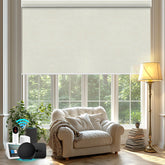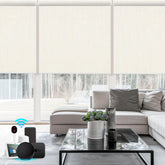Do Light Filtering Shades Block Heat?
If your windows are due for new covers this year, most likely this question has crossed your mind. Do window covering light filtering shades block heat? They certainly do, but only to some extent.
Light filtering shades are meant to reduce glare and soften sunlight, while also making your home feel cozy. However, whether they can keep heat out depends on your use, the fabric, and the design.
You can learn about the extent to which heat-light filtering shades can block, how to maximize heat control while preserving natural light, and the most suitable options for your needs.
What are Light Filtering Shades?

Light filtering shades are window coverings that grant you the desired privacy while still letting in soft, natural light. They use semi-opaque fabrics that work to diffuse sunlight instead of blocking it completely.
This way, you can enjoy natural lighting without the glare and heat that come with sunlight.
Key Features:
- Allow gentle and natural light to pass through.
- Reduce glare on furniture and screens.
- Minimize fading damage caused by UV rays.
Popular Types and How They Differ
Promote a friendly and inviting atmosphere.
- Roller Light Filtering Shades: Uncluttered design that is neat and minimal. Ideal for sleek and contemporary spaces.
- Roman Light Filtering Shades: Soft and structured fabric folds for a timeless, sophisticated look. Ideal for adding softness to a room.
- Cellular/Honeycomb Light Filtering Shades: Honeycomb shades can control light and temperature and have insulation with air pockets.
- Sheer Shades: Combines sheer fabric with adjustable vanes for light and privacy customization.
Pro Idea: Motorized shades, like smartphone-controllable light-filtering shades, will be available from many brands.
A highly recommended brand is Bringnox, a China-based company well-known for offering reliable, stylish, and energy-efficient products.
Their motorized light-filtering shades come equipped with advanced remote and app-controlled systems, making them perfect for any smart home.
How Do Light Filtering Shades Block Heat?
While light filtering shades are not meant to provide complete blockage of sunlight, some room entry heat reduction is achieved. This is achieved with a combination of the fabric’s design, color selection, and insulation.
Light-filtering shades use a few key principles to manage solar heat without blocking your view.
1. Fabric Density: A tightly woven fabric won’t let as much sunlight through. The denser the material, the more heat it keeps at the window while still letting soft, diffused daylight enter.
Example: A premium polyester shade can stop 60–70% of UV radiation without turning the room dark.
2. Color Choice: Believe it or not, a shade’s color can significantly influence how much heat gets reflected or absorbed.
3. Lighter tones: think white, cream, or soft gray—tend to bounce more sunlight away, while darker hues may grab heat to lower glare a little more.
4. Insulating Properties: Some light-filtering shades, like cellular styles, come with honeycombed pockets that create dead air layers. These air layers trap warmth or chill, boosting the shade’s energy-saving profile compared to a flat panel.
Fun Fact: Light filtering shades, even though less powerful than blackout shades, are still adept at lowering indoor temperatures by 3 to 5 degrees Celsius during hot afternoons.
Factors That Affect Heat Blocking
Not all light-filtering shades work the same way. To determine how well the tackle heats, some vital factors are:
Fabric Material
1. Polyester Blends: They are durable, easy to clean, and have an innate resistance to fading. Fabric polyester is known not to be heat-adapted. However, many modern polyester fabrics are treated with UV-blocking coatings, which increase their heat-controlling capabilities.
2. Natural Fibers (like cotton or linen): Fashionable and sustainable choices. However, these materials do not block heat as effectively, unless complemented with a thermal backing.
3. High-Performance Fabrics: These materials are designed specifically to provide better thermal control with reflective layers and tighter weaves. These are particularly good for sun-drenched and hot rooms.
Pro Idea: For hot climates, fabrics labeled as “thermal light filtering” will provide better results.
Shade Color
1. Light Colors: Light shades are best for reflecting and deflecting heat and sunlight, thereby keeping rooms cooler. Light hues brighten the space and make the room feel larger.
2. Dark Colors: While dark shades are more effective at reducing glare, they are not advisable for hot climates as they absorb more heat. In cold climates, this can be beneficial.
Pro Insight: For those who love dark colors but are worried about heat, a white reflective lining on the back will do the trick.
Mounting Style
1. Inside Mount: Sleek and tidy, the style fits the window frame. However, as with this style, small gaps of light (and heat) can be let in at the edges.
2. Outside Mount: This style extends beyond the window frame, covering a greater section of the window. This results in blocking more sunlight, but as with the previous style, this is better for heat control.
Pro Idea: Many homeowners will combine inside-mounted shades with outside-mounted curtains for maximum layered heat protection.
Comparison of Light Filtering Shades with Other Options
| Window Treatment | Heat Blocking | Light Control | Privacy | Energy Efficiency |
| Light Filtering Shades | Moderate | Softens light | Medium | Moderate |
| Blackout Shades | High | Full darkness | High | High |
| Solar Shades | High (UV-focused) | Maintains view | Medium | Moderate |
| Cellular Shades | High | Soft or blackout | High | Very High |
If your primary focus is maximum heat blockage, consider using solar or cellular shades. On the other hand, if you're looking for a balance of light and comfort, light-filtering shades are a great option.
Benefits of Light Filtering Shades in 2025
Light filtering shades do not function simply as window dressings. They enhance comfort, efficiency, and style within the home. With the advances made to fabrics and technology, light-filtering shades will be more functional.
Comfort Without Darkness

One of the appealing choices light filtering shades bring is the balance they strike in function. You are able to have a room that is brightly lit with natural light, yet is not overheated or blasted with harsh sunbeams.
The opposite of blackout shades that tend to create a stuffy and cozy feel, light-filtering shades maintain a sense of openness in the room.
Example: In the late afternoon sun, the light filtering shades in the living room can block intense light so you can relax or watch TV without having to move furniture around.
UV Protection
In addition to furniture and floors, light can also damage fabrics in a slow yet consistent manner. Light filtering shades block a considerable amount of harmful UV rays, which results in skin protection indoors.
Brands also manufacture fabrics with UV protective coatings, which are a relief while granting light access indoors.
Energy Efficiency
Although light filtering shades offer less insulation, they are effective in the summer. During the summer, light-filtering shades enable the room to remain cooler by blocking a portion of heat gain and reducing heat loss on mildly warm winter days.
In combination with other energy-efficient features like double-glazed windows or thermal curtains, the light-filtering shades can perform better.
Style Variety
Every taste, including modern minimalism and farmhouse coziness, can now find light-filtering shades. In addition, the shades offer a variety of:
- Bold or softer shades and neutrals to warm and cool tones.
- Textured, smooth, woven, or patterned fabrics.
- Roller, Roman, sheer, and cellular are examples of styles.
Pro Idea: Brands like Bringnox are offering custom designs that allow you to select the fabric and color, as well as the smart control features.
How Much Heat Do They Really Block?
With advancements in weaving technology and high-performance textiles, light filtering shades are capable of blocking 20–40% of heat gain from sunlight. While this range is modest, the reduction in indoor temperatures is noticeable during the summer.
Ways to Increase Heat Blocking:
- Pair with thermal liners: Increases effectiveness, particularly for bedrooms or sun-facing rooms.
- Use with double-glazed or low-E windows: Improves overall building insulation.
- Select cellular light filtering shades: The air in honeycomb designs traps heat, so the shades work more effectively.
How to Improve Heat Blocking with Light Filtering Shades
Do you appreciate the warm glow that light-filtering shades give to a room, but struggle with heat control? Here are some options to enhance their functionality.

1. Layering
Consider blackout curtains or a second set of blinds to increase the layers of your window treatments. The additional layer traps air, thus slowing heat transfer.
Example: A room can be kept cool if a light-filtering roller shade is paired with blackout drapes, especially during the peak summer months.
2. Adding Reflective Liners to Your Shades
Adding a heat-reflective liner to your shades, which is often white or metallic in color, can help prevent heat from getting in. Some of these liners can be switched out, so they can be changed seasonally.
3. Close Shades 11-3
The midday sun from 11 a.m. to 3 p.m. can noticeably raise indoor temperatures. Closing shades during this time can help keep the indoor temperatures comfortable.
4. Consider Smart Shades
Bringnox motorized light filtering shades can be programmed to close during peak sun hours or can be done so using a sunlight sensor. These shades will provide maximum heat blocking while requiring no additional effort from you.
Best Rooms for Light Filtering Shades
With the exception of a few rooms, shades can be used in any part of the house.
- Living Room: Maintains a bright space while reducing the heat and glare that the sun may offer.
- Dining Room: Provides softer light during mealtimes without distorting color accuracy.
- Home Office: Reduces screen glare while maintaining an energizing, well-lit room.
- Bedrooms: Best for those who want to wake up with the light, but do not want to squint from direct sunny rays.
Top Idea: For more privacy in a bedroom while still waking up to natural light, consider a dual roller system: one light-filtering shade and one blackout shade.
Do Light Filtering Shades Work Year-Round?
Yes, light filtering shades are beneficial in the summer and the winter.
- Summer: Reduces glare and heat gain; light filtering shades ensure your cooling system works less.
- Winter: Light filtering shades soften light and provide a light layer of insulation.
However, in the cold months, they are not as good at trapping heat as insulated cellular shades or thermal curtains. If you live in a region with cold winters, consider adding an extra insulating layer at night.
Maintenance Tips for Long-Lasting Performance
If you take care of light-filtering shades, they can last for many years.
- Dust or vacuum the shades to prevent a buildup of dirt.
- Spot clean with a mild soap and water solution when necessary.
- Avoid harsh scrubbing as it can damage the fabric.
- Gently operate the shades to avoid fraying or mechanical issues.
With simple upkeep, your shades will stay fresh and functional for a long time.
Conclusion: Do Light Filtering Shades Block Heat?
The answer is yes, light-filtering shades block heat, although not as effectively as blackout or fully insulated shades. Stronger fabrics and technologies will have improved heat reduction, especially with layering or reflective liners.
If your goal is a bright, stylish, and comfortable home while minimizing heat, light-filtering shades will work best.





